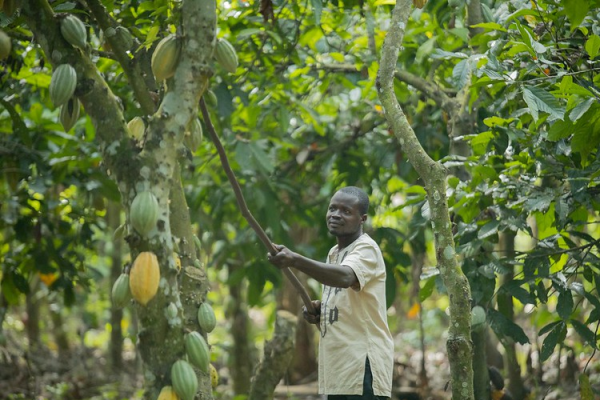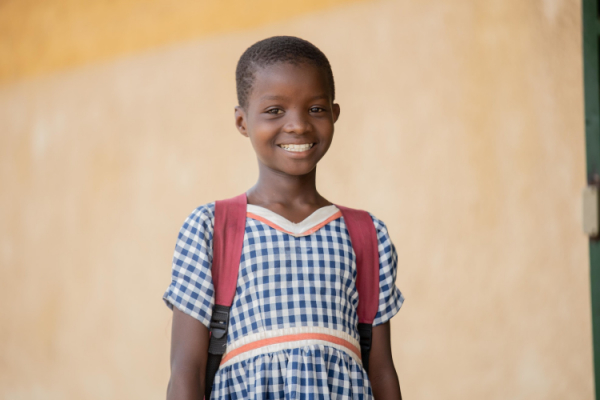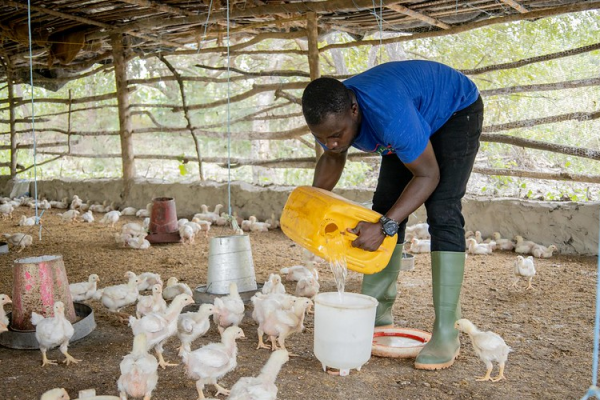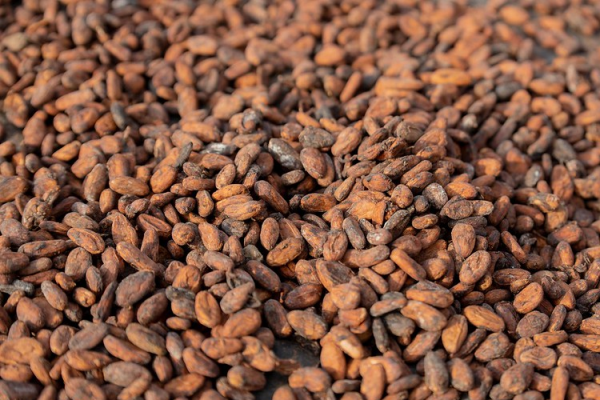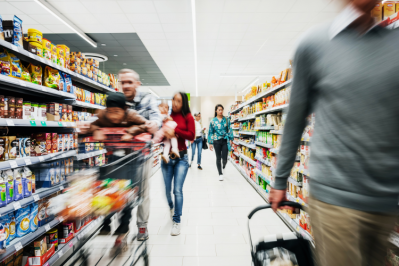Behind Nestlé’s CHF1.3bn drive to bridge the living income gap in cocoa
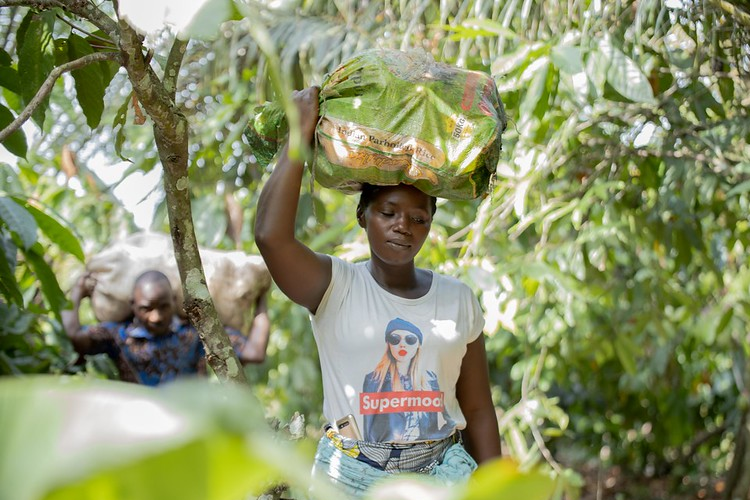
Almost 75% of smallholder cocoa farmers in Ghana and Ivory Coast do not earn a living income. Data from Wageningen University & Research reveals that small scale farmers in Côte d'Ivoire earn on average $1.23 per day, when the living income benchmark is $2.55. This means that many cocoa farmers in this West African country would need to more than double their income in order to afford a decent standard of living.
The issue is of massive importance for the health of Côte d'Ivoire’s economy where more than two million growers produce cocoa, a crop that employs almost 25% of the country’s population either directly or indirectly and accounts for around half of the nation’s export revenue.
“This product is incredibly important for our economy,” Prime Minister Patrick Achi stressed at a recent event convened by Nestlé. “Income for people is the greatest concern, ensuring young people can become involved in the economy and earn enough money to live a decent and dignified life.”
In a sector where the price of cocoa has halved over the last 40 years, Achi said people face ‘many problems’. “If we cannot find a way to significantly improve these income levels the situation will only become more volatile,” he warned.
The Prime Minister linked poverty to two issues that have plagued cocoa production: child labour and deforestation. “When farmers don’t have enough income, they use their children to work on plantations… Anyone who has children wants to send their children to school, have hopes for their children,” he stressed.
To improve their incomes – and the outlook for their families - farmers may attempt to increase the amount of cocoa they produce. But poor agricultural practices and low yields can mean these efforts are associated with deforestation, Achi continued. “If farms need more land, that would lead to deforestation, which would have a negative impact on the climate that we cannot stand for.”
One answer can be found in improving on-farm productivity, the Prime Minister suggested.
“For productivity to improve we need to select for higher yielding trees, we need to have more agricultural inputs available, we need to have some level of mechanisation that will allow us to produce in greater volumes and at higher quality. Of course, all that requires higher investment.”
In a Catch-22 situation, the higher on-farm investment that would increase incomes is simply beyond the reach of many cocoa farmers. Poverty has thus become a self-perpetuating cycle in cocoa production.
Accelerating farmer incomes
Food giant Nestlé shares a similar assessment of the situation, linking low farmer incomes to some of the major risks it faces in the supply chain.
“The risk of child labour in the cocoa supply chain is a risk we face. We have been working on reducing that risk for many years, starting in 2009 when we put in place the Nestlé Cocoa Plan. We have gathered a lot of experience during that phase, we have learned what works better and what works less well. We have learned one thing that seems obvious: to be able to reduce the risk of child labour we need to tackle the root causes head on,” Nestlé operations chief Magdi Batato told FoodNavigator. “Those root causes... [include access to] education; income; and gender equality. All these societal evolutions that can help or hamper. It can be an enabling factor or a hurdle.”
The Swiss company is piloting a new income accelerator program with 1,000 farmers in Côte d'Ivoire to boost earnings through increased productivity and income diversification.
Productivity and diversification have long been a popular mantra in corporate sustainability programmes – but Nestlé’s latest efforts come with a twist. The company is offering direct payments to farmers with cash incentives paid against four metrics, which include good agricultural practices such as pruning to improve productivity, agroforestry to build climate resilience, income diversification through the cultivation of other crops or livestock, and school enrolment for children in the household aged 6-16.
Farmers receive a payment of CHF100 per target, with a CHF100 bonus if all four goals are met. Unlike many standard approaches, these payments are not linked to cocoa volumes and payments are split between the farmer and their spouse to support gender equality.
The CHF500-worth of financial incentives will be available for a period of two years at this level, dropping to CHF250 thereafter. The idea is not to simply supplement farmer incomes but support a transition towards the adoption of better agricultural practices that will result in higher yields and ultimately increased income, Batato suggested. “We have discovered there are good agricultural practices and enabling practices that help the normal income of a farmer. Take for example productivity per hectare of land. The average farmer in Ivory Coast produces something around 300 kg per hectare. If you take a farmer that has been part of the [Nestlé] Cocoa Plan in the past, we reach on average 600 kg per hectare. If you take the outcome of the pilot, we can reach up to 1.5 tonnes, which is 1,500 kilos per hectare. What does this mean? We can triple yield for the same piece of land. This is good for the environment. It is also good for the pocket of the farmer or the household.”
The pivotal point is making sure these payments are linked to the adoption of sustainable practices that make farmers more ‘self-sufficient’, Batato stressed. “The last thing we want is those incentives to be like a band aide, when you take it off the whole thing collapses.”
He said Nestlé is confident farmers will begin to see the benefits after two years, when support will be reduced. The COO also revealed that the cash payments result in higher participation and engagement levels: “Whereas today more or less 18% of farmers [in the Nestlé Cocoa Plan] would adopt practices, in that structured approach of 1,000 farmers [in the pilot] 80% adopted those practices. We saw a direct link to productivity and sending kids to school. It is understandable... The farmer does not intentionally go into child labour, the farmer does not do this with a bad intent. They don't have resources, sometimes they are forced to do that. When they see the income increase and the situation becoming more prosperous, why would they not send their kids to school?”
Listening to farmers
Direct financial support is just one part of the scheme, that will see an investment of around CHF1.3bn over the next decade. Nearly half of the spend is on ‘enabling elements’ to train the farmer, get ‘boots on the ground’, work alongside NGOs and verify and certify progress, we were told. Nestlé’s cocoa lead Darrell High revealed that in pruning, for instance, the company establishes, subsidises, and equips pruning groups that support best practice on farm.
For him, a vital aspect of the strategy is working alongside farmers and cooperatives and adjusting Nestlé’s approach based on their feedback.
“There are no silver bullets in any of this,” he told us. “Listening [to feedback] is an important theme. We come through with our ideas, we know what we want to change, we see the end goal - but we have to have the coops and farmers with us on this journey. So, when we get suggestions to improve and tweak the program, we take those into account.”
An example of this tactic in action is the way that payments are distributed throughout the year to assist with cashflow, with different KPIs paying out at different seasonal pinch points. Again taking pruning as an example, part of the payment is delivered when a farmer commits to pruning and the remainder is paid on completion. This provides access to the capital needed to cover expenses.
“For cashflow purposes cocoa farmers prefer to receive payments at specific times of the year. This includes before school, so it helps for school enrolment but also coincides with the harvest. It is not a blanket approach, payments are made at the right time of the year on a cyclical basis,” Batato added.
Aka Hyacinthe, Chairman of the SOCAYEMA cooperative that is participating in the pilot, revealed members are already reaping the benefits of better agricultural practices and diversified earnings.
“Nestlé supports producers and coops. This allows us to send money to producers that gives them the strength to keep going. Producers who receive this money are able to send all their children to school and pursue other activities [like] raising poultry to help supplement their incomes. This has allowed cocoa farmers to earn more money in different ways and therefore meet their families’ needs.
“This programme helps growers who are working on their own land and harvesting cocoa beans and who often are paid very low prices for their cocoa. It helps them see how they can better manage their plantations, how they can work more effectively and produce more. That allows them to produce better cocoa that is passed on to suppliers," Hyacinthe said.
Scaling-up for 100% traceability
Nestlé hopes to build on this pilot. In total, 160,000 cocoa farmers supply Nestlé. "We want to scale this up to 10,000 in a couple of years so we will have enough statistics and a critical mass [to] have confidence to go 250,000. The intention is to move to 160,000 farmers, which covers the whole global supply chain,” Batato detailed.
The ambition for the income accelerator to cover the entire cocoa supply chain is in line with Nestlé’s target to reach 100% traceable cocoa by 2025. Today, 51% of what Nestlé buys comes through the direct supply chain. For the rest - like many other players on the market - the company purchases sustainably sourced beans but these are mixed with other beans because the volumes are not physically separated from the conventional supply chain, a system known as mass balance.
Shifting to fully traceable cocoa is a ‘massive endeavour’ that requires the segregation of cocoa beans purchased by the company, Batato explained. “It means 100% of our supply - and we are not limiting ourselves to beans we are covering cocoa butter, liquor and powder. All of our cocoa products will be linked to the 150 factories that we have that manufacture confectionery and other cocoa malt beverages. We will be able to ultimately link it to the two-finger KitKat, as an example.”
While he recognises the scale of the task ahead, the supply chain expert believes Nestlé will be able to accelerate action to meet its 2025 traceability deadline. He noted that Nestlé already segregates direct supplies for other commodities, such as cattle feed and rice. "It isn't that we are discovering something totally unknown to us. We know how to do this and we are doing it with various types of commodities. It simply takes time, that's why it is a journey.
"I believe [cocoa traceability] has already accelerated in a sense that it is a bold ambition. We have learnt a lot; we are not starting from scratch. If we were, this would be an impossible task. But we know the people in our value chain, we have done responsible sourcing, we have done traceability. It is simply scaling up that. We are not going to work alone. We will work with suppliers on this - Olam, Cargill, Barry Callebaut - we will work alongside NGOs and we have boots on the ground. It is leveraging various tools and it is building on 13 years of quality progress.”
Speaking at Nestlé’s event to detail its income accelerator pilot, Cargill’s Group Sustainability Lead for cocoa Kate Clancy confirmed that the initiative is ‘very similar to Cargill’s own approach’. “Earning a living income is going to be challenging for the majority of cocoa producers. For that reason, the fact that this programme promotes a number of complementary income generating activities… and uses cash incentives to encourage behaviour change… will be crucial to success,” she suggested.
For Nestlé’s High, the development of long-term relationships will prove an essential unlock for greater traceability. “It’s all about transforming the supply chain to have stable long-term relationships with our partners. In Côte d'Ivoire, the classic way farmers are organised is cooperatives. That is not the case in every origin country. The key is how can we have transparency, traceability and long-term relationships for the benefit of the farmers.”
Who will foot the bill?
Nestlé intends to introduce a range of products with cocoa sourced from the income acceleration program, starting with a selection of KitKat products in 2023. “We will start with KitKat, which is a brand that is big, important, and close to our hearts. By 2023 we will have enough fully traceable volumes that we can then tell the consumer the story. To mark the event, we will launch a special edition for KitKat,” Batato said.

Nestlé believes that this approach will resonate with consumers who are gaining awareness of supply chain issues. “This will increase the sense of purpose of our brands. Consumers are pulling for this. Consumers want to know where the product comes from, which supply chain, which company, which farmer. And we can tell those beautiful stories. That's why we are linking the consumer to this journey.”
Indeed, various consumer studies support the notion that shoppers want more sustainable food brands. Recent research conducted by Kantar in the UK, for instance, suggests sustainability is now as great a motivation as wellness in food purchases and lifestyle choices. But at the same time people are facing rising food prices at the checkout – as well as a more general cost-of-living squeeze – that is hitting confidence. In this inflationary environment how much price elasticity is there for Nestlé to pass the cost of this fresh sustainability drive along to consumers?
Batato responded that the incomes initiative will be funded by a combination of pricing and cost cutting. Margin, he said, will remain unaffected. “In some cases, we will be able to price up some of those products. In other cases, less. These are market dynamics. But above all we will also generate efficiencies within our own value chain, which we have been doing for years. The promise made to shareholders is that we are not going to say margins will be impacted because of this. We have never done it in the past, we will never do it in the future, that is clear. Keeping the right balance is very important.”
While the investment and the sourcing stories might not directly result in higher pricing, Batato believes that it nevertheless builds brand value for Nestlé confectionery products.
“It is the right thing to do, it is valuing up the brands, creating this trust with the consumer. That gives us long-term market sustainability, gaining market share, connecting better with the consumer. But we will do our job, which is to find efficiencies inside our operations, find savings, and keeping our margins in line.
“Everything we do on sustainability comes with a cost. When we announced our climate change roadmap and that we will pay a premium of CHF1.2bn for regenerative agriculture there were of course associated costs... But we do our due diligence, we generate those efficiencies, and whenever we can have a pricing mechanism that can reflect some of that we will use it.”
